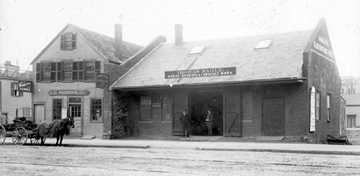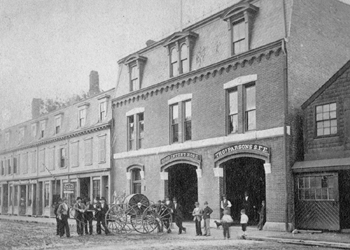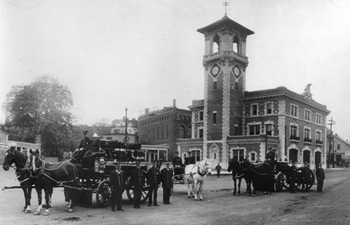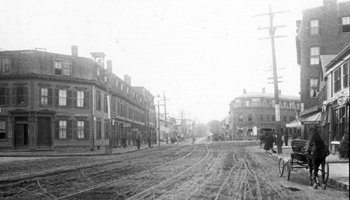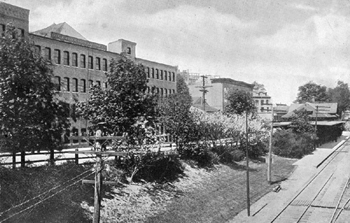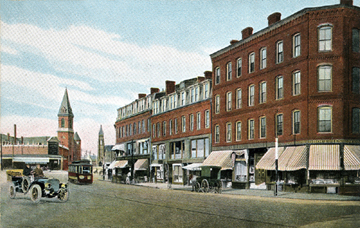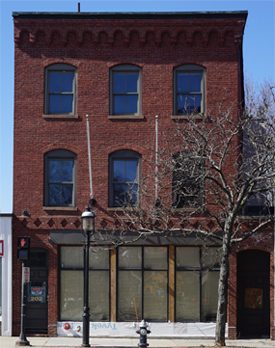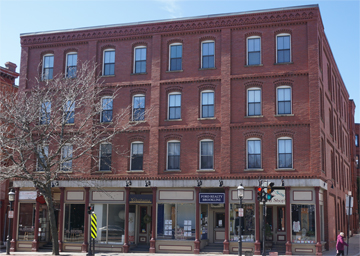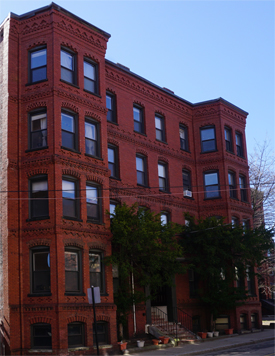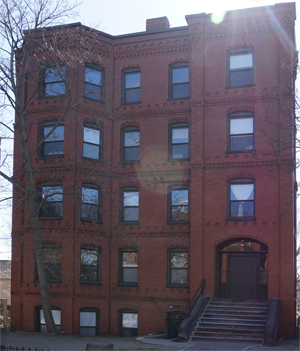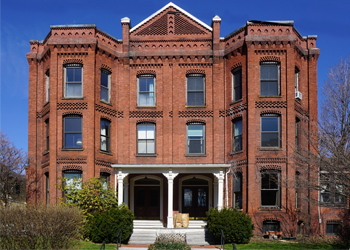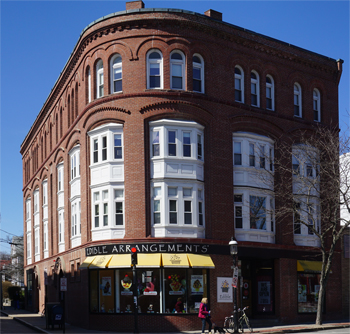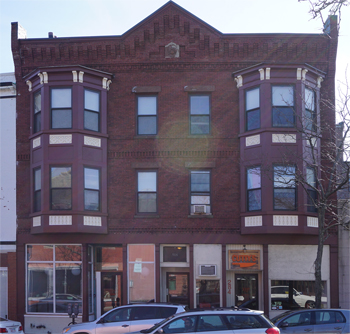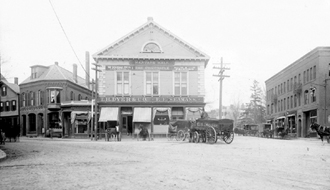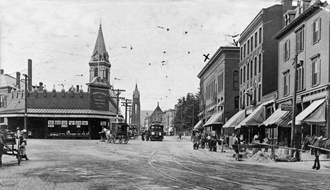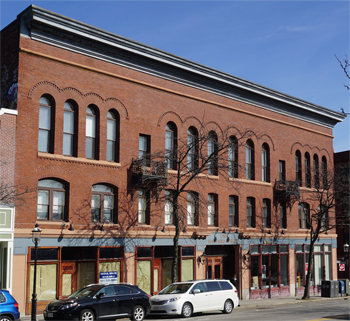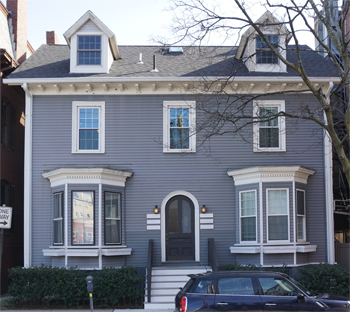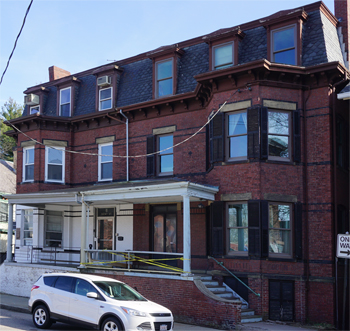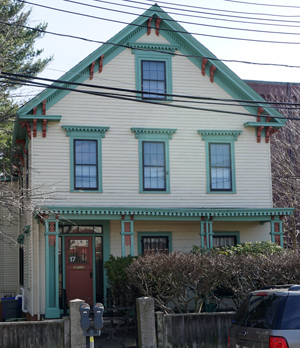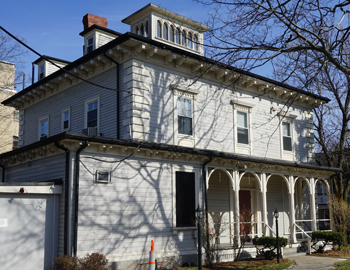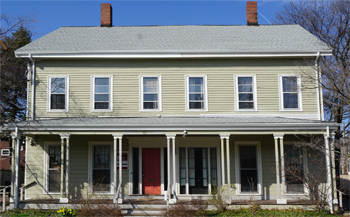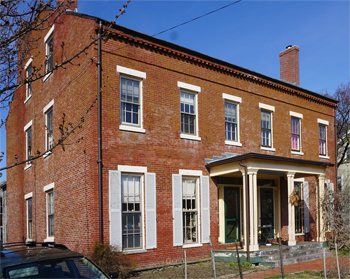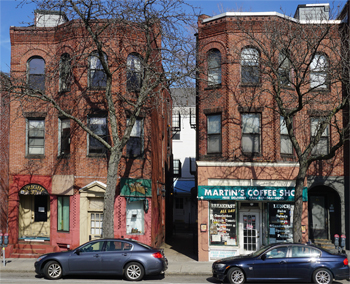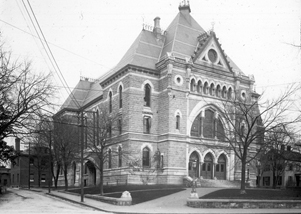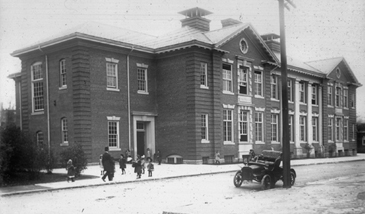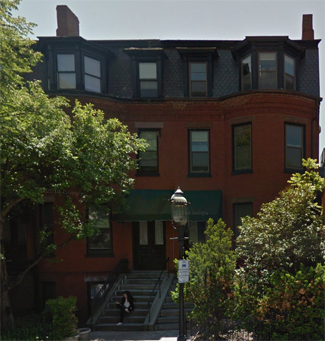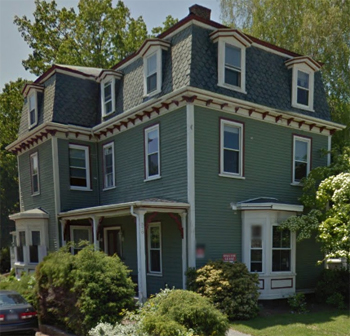Courtesy, Brookline Preservation Commission
Please see these related links:
- An introduction to Village architecture
- Our Brookline Village photo collection
- The Linden Place walking tour
- The Emerson Garden walking tour
[Editor's note: It is often not understood that today's Rt. 9 actually combines two streets: Washington St., which extends eastward from the former Brookline Bank building (referred to as "Lower Washington St.") and Boylston St. which extends westward from that point.
The walking tour of the Village begins at the Hearthstone Plaza, the former site of the Punch Bowl Tavern. The early development of the Village was centered around this well-known tavern which served "refreshments for man or beast." Strategically located, all wagons and stagecoaches travelling to Boston from the west or north passed by this popular inn. Indeed, the Punch Bowl Tavern was so associated with the Town during the eighteenth and early nineteenth century that many travelers simply referred to the community as "Punch Bowl Village". However, with the construction of the Mill Dam in 1821 (Brookline Avenue), new bridges to Boston, and the opening of the Worcester Railroad, the Punch Bowl Tavern ceased to be the Town's nucleus. [1A] The tavern was razed in 1833, and a variety of local businesses and residences soon dotted both sides of Washington Street. Most of these remained until the 1960s when renewal efforts prepared the way for the present development.On the south side of Washington Street lies the area still known as the "Farm". This land was property of the Ward and Kimball families from the late eighteenth century through the mid 1850s. The old Ward farm, originally part of Roxbury until it was annexed to Brookline in 1844, stretched from Pond Avenue to Chestnut Street and from Washington Street to Jamaica Pond. About 1860 the land was sold to the Brookline Land Company and subsequently subdivided into lots. Shortly thereafter it was purchased by John Panter, a key figure in the development of the Village Square area. Gradually the lots were sold off, and by the late 1890s a small neighborhood, comprised of a mixture of three-deckers, small frame structures, and local businesses, had developed.
[1B] The Fire Station block has also undergone a series of changes through the years. Until the mid-nineteenth century it was part of the Thomas White estate which, bounded approximately by Walnut Street and Davis Avenue, stretched south to the site of the Lincoln School on Boylston Street. In the 1860s, "Whyte's Block" was built on the easterly portion of the lot, having a row of stores, newsstands, fruit and cigar shops, and various other small enterprises. At the opposite end was Mr. Quinlan's carriage shop. Today, the only structure remaining on the block is the Fire Station, a successor to the former Good Intent Engine Company which stood at the same location. Designed in 1908 by the architects Freeman, Funk and Wilcox, the existing building is a massive red brick structure with white sandstone trimming and a copper cornice. With its swollen brackets and off-center tower, it is an assertive example of Italianate design.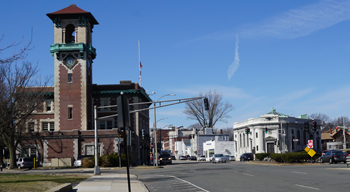
Brookline Savings Bank building, rear right
After briefly doing business from the Colonnade Building, it was moved to a location near Harvard Square; then in 1898 moved again to 366 Washington Street, now the Brookline Gospel Chapel. In 1922, the existing bank building was constructed by the local contractor James Driscoll & Sons after designs by the architect F. Joseph Untersee. Driscoll proceeded with the construction of the "Buckeye Gray Sandstone building, with the Bank Seal in Bronze Medallion over the front door, and Tavernelle Rose Marble and mahogany interior finish." [3] Typical of this building's Beaux Arts style are the classical symmetry, the round arched windows, the presence of multiple pilasters, and the dominant glass dome. Thus, thirty five years after McKim, Mead and White revived elegant classical traditions in their design of the Boston Public Library, Brookline Savings Bank was exemplifying a similar architectural theme.
The railroad dramatically changed the commercial development of Brookline Village. Lower Washington Street no longer was the hub of Brookline. Instead, one began to witness the growth of "Harvard Square", the so-called intersection of Harvard and Washington streets. As the end of stagecoach travel precipitated the decline of the Punch Bowl Tavern, the coming of the first steam engine in 1848 led to the emergence of Harvard Square as the next commercial center of Brookline.
Looking down Station Street, note the large four-story brick buildings. Built around the turn of the century these structures housed the Holtzer-Cabot Electric Company, Brookline's first industry. In 1874 Mr. Charles W. Holtzer began his electrical appliance business in Harvard Hall [Editor's Note at the apex of Harvard & Washington]. By the early 1900s, the company had outgrown its Brookline plant and opened a second plant in Boston. Finally, in 1915 the Holtzer-Cabot business abandoned its Station Street operations. Since that time, the building has been used for a variety of commercial and light industrial uses.Walking along Washington Street, one cannot overlook the fine collection of Panel Brick buildings lining both sides of the street. The Panel Brick style flourished during the 1870s and 1880s throughout the Boston area. As the name indicates, brick masonry was used to create a decorative pattern of projecting or receding panels.
Trademarks of the style are stepped corbel tables, string courses with geometric indentations, and various cross-shaped panels which animate the facade with their crisp patterns. The Panel Brick ornamentation is often centered at points of architectural interest such as cornices, pilasters, windows, and doors. The wall surface itself is also divided into panels of ornamental detail which vie for the eye's attention. Historically, the Panel Brick style holds a critical position in architectural development. First, it indicated a decided break from the restraining canons of classical architecture prevalent through the Civil War. Second, the experimental way in which brick designs were substituted for classical details was a prelude to the individualistic forms and varied materials of the Queen Anne style. Third, the Panel Brick style may be viewed as an early attempt to design a building which reflects the nature of the building materials, an attitude which looked forward to the work of H.H. Richardson in the 1880s.
[4] One of the early examples of the Panel Brick style in the Village are the Colonnade Buildings at 207-241 Washington Street. This property and, in fact, all of the land in the Village Square were part of the Davis farm through the early nineteenth century. In the late 1860s, John Panter purchased the large lot between Andem Place and Station Street from Ginery Twichell and the Boston and Albany Railroad Corporation. Mr. Panter paid $12,000 for the open pasture and a dwelling. In 1872, he built the northerly and middle sections of the Colonnade Building; in 1875 the portion of the building abutting Station Street, originally known as the Monteith, was completed. This southerly portion is the only section which has remained largely unaltered through the years. The other two sections of the Colonnade have both undergone major renovations so that the original fenestration remains only on the third floor. In spite of these changes, many details can still be seen such as the brick pattern between floor levels, the corbelled cornice, the segmental arched windows with radiating brick voussoirs, and the cast-iron Corinthian columns. [5] Across the street is an attractive building which had previously been a fish market and a hardware store. Built in the late 1870s or early 1880s by Mr. Reuben Chace, the building's interior and exterior were restored in the 1970s. Again, note the segmental arches above the windows and the recessed diamond brick patterning motif between floors. An equally attractive detail is the arched brickwork along the cornice with stepped corbels creating a dropped pendant effect. [6] At the eastern corner of Davis Avenue and Washington Street stands another brick edifice, the St. Andrew Building. Formerly part of the Davis estate, this parcel came into Mr. Panter's possession in 1866. Mr. Panter paid $10,848 for the property and in 1875 erected the St. Andrew Building and the Davis Mansion*. Again one sees many of the same features exhibited by the Colonnade Building across the street-the segmental arched windows, the string courses separating the various floors, the elaborate brickwork along the cornice, and the Corinthian columns. Of course, the decorative brick patterning is not exactly the same. Rather each building has unique detail- a spontaneous combination of angled, "stepped", pyramidal, or diamond shapes. Another interesting feature of the St. Andrew Building is the division of the facade into many separate units. This is achieved not only through the use of string courses, but also through the interplay of recessed bays and the slightly projecting columnar brickwork.[7][8] A brief detour down Davis Avenue reveals three magnificent Panel Brick residences, which dominate the streetscape. At 10 Davis Avenue is the Davis Mansion built in 1875, and to its right the McLeod Mansion. In 1885 Mr. Panter joined with a Dr. T.E. Francis in the purchase of the only remaining parcel of the Davis estate on this street. Upon his portion of the land Mr. Panter built the McLeod Mansion in memory of his deceased wife.
[9] Across the street at 11-15 Davis Avenue is a building constructed several years after the Davis Mansion. Of particular note is its central gable, piercing the flat roof with its unusual checkered brick. The resemblance of these three buildings to the Panel Brick commercial buildings on Washington Street is easy to see. There are brick, string courses, arched windows, and stepped corbel tables. However, there are differences. First, the facades of these residences are broken by polygonal multi-storied bays in contrast to the predominantly flat facade treatment to be seen on Washington Street. Second, the recessed cross motif, a typical device of the Panel Brick style, is highly developed on these buildings. [10] At the western corner of Davis Avenue and Washington Street is a fine four-story brick building, erected by Mr. James M. Seamans who, along with Mr. Panter, was a key figure in the development of the Square. In 1866 he bought this corner lot and relocated his grocery business from his lower Washington Street address. In 1888 he moved the two-story wooden structure which had been on this site and erected the existing brick building. Built from designs of Messrs. Shepley, Rutan, and Coolidge, a successor firm to H.H. Richardson, it is an early example of thoughtful urban design. Unlike its many neighbors, the emphasis is not solely upon decorative brick patterning. Rather, it echoes the Richardsonian Romanesque tradition with its rounded corner edges and heavy arches. Yet it easily blends with the Panel Brick buildings in massing, height, and scale. [11] Further down at 280-284 Washington Street is a building constructed by Reuben A. Chace in 1875, which was known as the "Reubens". Also the first home of the Brookline National Bank (now the Brookline Trust Company) it is another fine example of Panel Brick architecture with its stepped corbel table along the cornice, decorative brickwork between the floors, and iron cresting along the central gabled roofline.[12] The intersection of Harvard and Washington streets has a long and interesting history. During the eighteenth and nineteenth centuries, the Dana Tavern stood here as a famous stopping place for farmers who came to Boston from the surrounding countryside to sell their produce. In the open space in front of the tavern were the town scales. When the Dana Tavern was destroyed by fire in 1816, a Baptist Church was built upon the site. In 1859 John Panter purchased the church and soon thereafter altered it into a business block by moving it to a position parallel with Harvard Street and constructing stores beneath it. Harvard Hall, the pedimented building in the old photograph, was soon erected on the pivotal intersection site. Finally, in 1905-6 the present edifice was constructed and became the home of Rhodes Brothers grocery business. A close look at the hip roof two-story structure of today's complex shows it was originally a separate building. Built approximately twenty-five years earlier than the one-story section, it was the former Village Post Office.
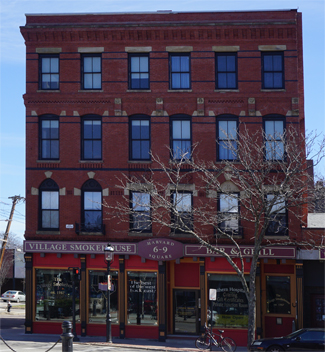
Webster Place, named for the great statesman Daniel Webster, is of a more recent vintage than Kent Street. However, it does boast two handsome structures at numbers 30-32 and 38-40. [21] In the Greek Revival style, 38-40 Webster Place was built between 1850-55. Characteristic of the style are the wide overhang of the roof, the floor-length windows, the flushboarding, and the pilastered door-way with sidelights. [22] It is believed that the Richard Crocker family was the original owner of 30-32 Webster Place. Mrs. Crocker was a Homer, niece of the famous artist Winslow Homer. Built between 1850-55, it is a transitional Federal style building. Characteristic of the period are the brick dentils along the cornice, the symmetry of the facade and the 6/6 windows. However, the full-length first floor windows and portico at the entrance are suggestive of the then-rising Greek Revival tradition. Returning to Harvard Street, one can see that most of the commercial buildings here postdate the earlier Panel Brick style of the Village development; yet several of these are worth noting. [23] The Woolworth building, a two-story brick structure built in 1933, boasts a unique copper skylight. [24] A more recent construction is the office building at 29 Harvard Street. Built in 1969, it shows how a modern building can be well-integrated with the old through a sensitivity to materials, height, and fenestration. [25] Mention should also be made of the two buildings at 35 and 37 Harvard Street. Built circa 1890, this pair has several noteworthy details-the modest stepped corbel table, the sandstone lintels, the "zipper" bricks on the projecting polygonal bays and the grouped windows of the third story. It should be recalled that the grouped windows were also seen on the Brookline Trust building and 256 Washington St.
[Editor's note: The Linden Place walking tour begins at St. Mary's church, just past 35 and 37 Harvard Street.
A number of blocks in the Village have changed significantly over the years, particularly the area around Town Hall. Where the small landscaped park is today used to stand the former Town Hall, a Gothic structure designed in 1871 by S.J.F. Thayer and demolished in the 1960s. Several other buildings in the vicinity were also torn down during this time, including the old Pierce Grammar School designed by J.A. Schweinfurth. Schweinfurth, who worked for the architectural firm of Peabody and Stearns, was one of the architects for the Pierce Primary School which is still standing. [26] The original form of this building, an Italianate structure hidden behind present facade, was constructed in 1855; late in 1904 Schweinfurth was hired to enlarge it. He did so in the Georgian Revival style using New Hampshire waterstruck brick and classical Indiana limestone trimming. It should also be noted that the Parish Hall at St. Paul's Church was modeled after designs of Schweinfurth.
[27] Before leaving this area, note the Italianate and Greek Revival houses on Holden Street which face the Town Hall Green. [28] As one walks down Washington Street away from the Village Square, do not miss the Second Empire apartment house on the left with its hexagonal slate roof, rounded bays, brownstone lintels, and decorative brick patterned cornice. Built in the 1870s, this brick block was once occupied by the astronomer Robert Treat Paine.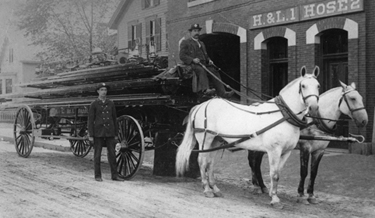
Fred Foster (standing) and George Newcomb (driver)
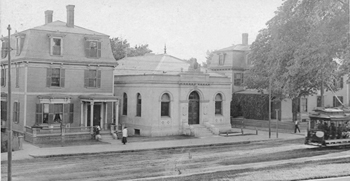
370 Washington St. visible on the right
(From the collection of Joel Shield)
© 2016 Brookline Historical Society
